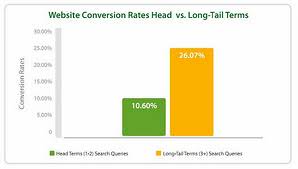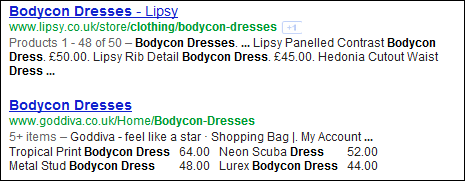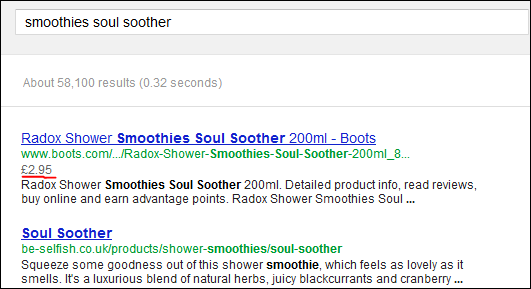Aimed at capturing a greater share of higher converting ‘long tail' traffic
 Ecommerce websites can inadvertently fall short of SEO best practice because, for example, the site may be accidentally riddled with crawler and duplicate content issues. Such issues are inherently linked to product optimisation, an oft-neglected aspect of SEO which is the focus of my post.
Ecommerce websites can inadvertently fall short of SEO best practice because, for example, the site may be accidentally riddled with crawler and duplicate content issues. Such issues are inherently linked to product optimisation, an oft-neglected aspect of SEO which is the focus of my post.
It’s surprising how often ecommerce sites neglect this dimension of SEO.
People tend to be distracted by the high volume head and middle keyword terms and forget to pay attention to the crucial keywords pertaining to the long tail.
Many sites succeed in capturing a fair amount of long tail traffic without paying particular attention to it. Nevertheless, it’s still important to capture as much of long tail traffic as possible because long tail traffic converts better than head term traffic.
Tip 1 - Duplicate product content
Serve products on a single URL whenever possible.
A single URL may not be achievable because products might occupy multiple categories, giving them alternative URL directory paths. For example;
A diesel denim shirt would be best served as
http://www.example.com/products/1992-diesel-denim-shirt
instead of sitting in alternative categories where duplication can occur, such as
http://www.example.com/diesel/diesel-denim-shirt.aspx
and
http://www.example.com/shirts/denim/diesel-denim-shirt.aspx.
In this scenario, it's best to use canonical tags (that’s another post in itself).
A duplicate content problem may also occur if there are multiple variants of the same product; for instance, when a product comes in different sizes and/or colours. A couple of options to combat this problem are:
- Serve on one URL - provide thumbnails to change the image if the colour is different but keep everything on one URL. This is an easier administrative option if you have less resource to write unique product descriptions for each variant of a product.
 Do make sure that the variant thumbnails have colour optimised alt text, or text below the thumbnail, to allow the page to be optimised for each product colour; for example, ‘black/blue/red bodycon diesel dress’.
Do make sure that the variant thumbnails have colour optimised alt text, or text below the thumbnail, to allow the page to be optimised for each product colour; for example, ‘black/blue/red bodycon diesel dress’.
Pros– Easier to implement, lessens duplicate content riskCons – Products aren’t as optimal for variant specific search terms
- Serve on unique URLs - a specific page per product variant allows you to optimise for each colour, or other product variant. This method still carries a duplicate content risk because products are still too similar despite some differences, such as colour and size.However, you can still avoid triggering duplicate content filters by producing a unique product description for each variation to more strongly differentiate each page.Pros– More optimal product pagesCons – Difficult to administer / come up with unique descriptions
Tip 2 - Product naming conventions
Make sure SEO is ingrained in the build and considered by everyone who updates the website. It is particularly important to include the admin people who add new products to the database.
It is common practice for product names to be re-employed in titles, headings and other key SEO areas, so product names must be created with search users in mind.
For example, a dress colour may be described as ‘cobalt’, a description unlikely to reflect most of the search terms searchers use when trying to find a ‘blue dress’. Changing the dress colour to ‘cobalt blue’ is likely to support optimisation of all sorts of relevant long tail search terms.
Instil a set of characteristics that must form part of the product title; an example from ‘fashion’ might look like this;
Colour Brand and product |Type | Category
Red Kurt Geiger Bikini Shoes | Courts | Shoes
Tip 3 - Product schema
Use product schema to make your listing richer. This technique has been proven to positively impact clickthrough rates:

 Mark-up your products correctly using the schema found here.
Mark-up your products correctly using the schema found here.
You can also include review schema and breadcrumb schema.

 Tip 4 - Product templates
Tip 4 - Product templates
Apply the following best practice elements to your product template:
- Unique Title
- Unique Description
- Breadcrumbs
- Optimal heading
- Friendly optimised URL’s
- Unique product descriptions
- Optimised alt tags on images
Tip 5 - XML sitemaps
Ecommerce sites generally have a large number of products, and therefore URL’s, within the site. It is vital to get the products indexed to capture the long tail. So, for SEO it is strongly recommended ecommerce sites submit all product URLs using XML sitemaps.
You can split your sitemaps up into the different categories and then bring them all together using a sitemap index file.
Here are some useful links to help you create search engine friendly sitemaps.
Once you have created your sitemaps, upload them to your domain and submit using Google webmaster tools.
 Thanks to Jimmy McCann for sharing his advice and opinions in this post. Jimmy is Head of SEO at Search Laboratory in Leeds. You can follow him on Twitter or connect on LinkedIn.
Thanks to Jimmy McCann for sharing his advice and opinions in this post. Jimmy is Head of SEO at Search Laboratory in Leeds. You can follow him on Twitter or connect on LinkedIn.
With thanks to Bloggers for use of the image.









 Thanks to
Thanks to 


